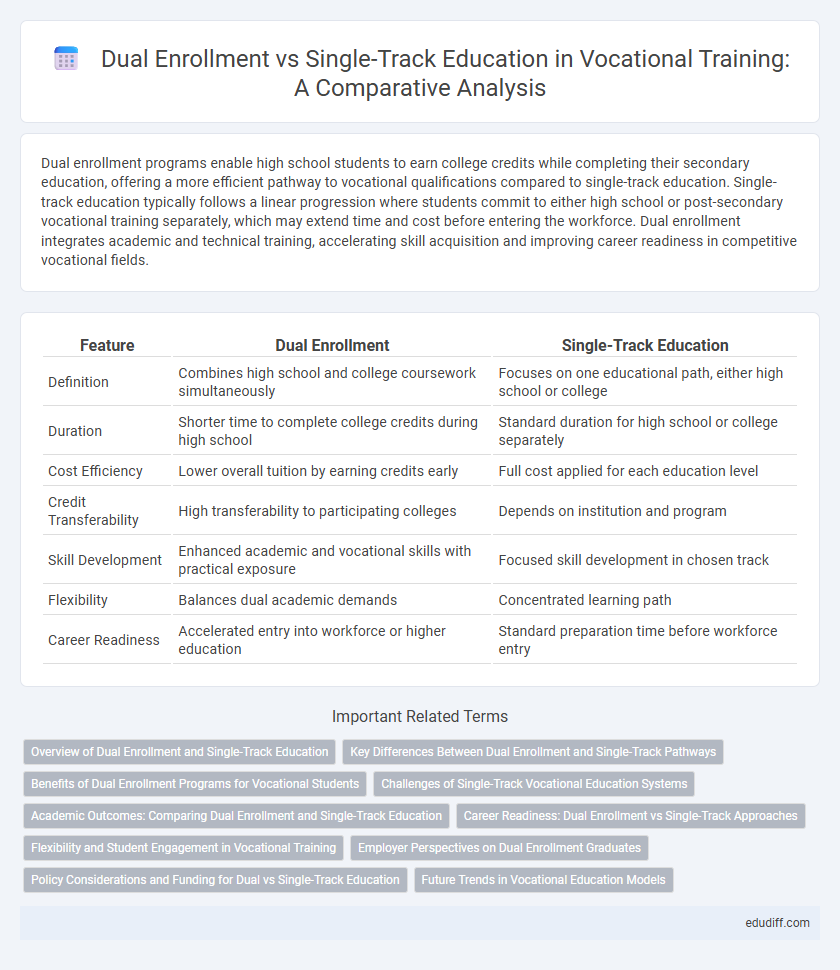Dual enrollment programs enable high school students to earn college credits while completing their secondary education, offering a more efficient pathway to vocational qualifications compared to single-track education. Single-track education typically follows a linear progression where students commit to either high school or post-secondary vocational training separately, which may extend time and cost before entering the workforce. Dual enrollment integrates academic and technical training, accelerating skill acquisition and improving career readiness in competitive vocational fields.
Table of Comparison
| Feature | Dual Enrollment | Single-Track Education |
|---|---|---|
| Definition | Combines high school and college coursework simultaneously | Focuses on one educational path, either high school or college |
| Duration | Shorter time to complete college credits during high school | Standard duration for high school or college separately |
| Cost Efficiency | Lower overall tuition by earning credits early | Full cost applied for each education level |
| Credit Transferability | High transferability to participating colleges | Depends on institution and program |
| Skill Development | Enhanced academic and vocational skills with practical exposure | Focused skill development in chosen track |
| Flexibility | Balances dual academic demands | Concentrated learning path |
| Career Readiness | Accelerated entry into workforce or higher education | Standard preparation time before workforce entry |
Overview of Dual Enrollment and Single-Track Education
Dual enrollment enables high school students to simultaneously earn college credits while completing their secondary education, facilitating a smoother transition to postsecondary training and reducing overall education costs. Single-track education focuses on a linear path within a single institution or curriculum, emphasizing specialization in a specific vocational trade without integrating parallel academic coursework. This approach offers depth in skill development but may limit exposure to broader educational opportunities compared to dual enrollment programs.
Key Differences Between Dual Enrollment and Single-Track Pathways
Dual enrollment programs allow high school students to simultaneously earn college credits, accelerating their vocational education and reducing overall time to certification or degree completion. Single-track education follows a linear path, focusing exclusively on either high school or post-secondary education without overlap, potentially extending the timeline for workforce entry. Key differences include flexibility in course selection, credit accumulation speed, and early exposure to college-level vocational training.
Benefits of Dual Enrollment Programs for Vocational Students
Dual enrollment programs offer vocational students accelerated pathways by combining high school and college coursework, enabling them to earn industry-recognized certifications earlier. These programs provide hands-on training aligned with labor market demands, increasing employability and reducing post-graduation education costs. Access to dual enrollment also fosters stronger connections with employers, enhancing internship opportunities and real-world skill development.
Challenges of Single-Track Vocational Education Systems
Single-track vocational education systems often face limitations in adaptability and skill diversification, restricting students to narrow career pathways. These systems struggle with integrating practical experience and theoretical knowledge, leading to skill gaps in rapidly evolving industries. Consequently, graduates may encounter difficulties in meeting labor market demands, reducing employability and career advancement opportunities.
Academic Outcomes: Comparing Dual Enrollment and Single-Track Education
Dual enrollment programs enable high school students to earn college credits, often resulting in higher academic achievement and accelerated degree completion compared to single-track education. Research indicates that dual enrollment participants demonstrate improved college readiness, higher GPA, and increased likelihood of postsecondary enrollment and retention. In contrast, single-track education typically limits exposure to college-level coursework, potentially delaying students' academic progression and limiting early access to advanced learning opportunities.
Career Readiness: Dual Enrollment vs Single-Track Approaches
Dual enrollment programs enhance career readiness by allowing students to simultaneously earn high school and college credits, bridging academic knowledge with practical skills relevant to the workforce. Single-track education often limits exposure to diverse career pathways, whereas dual enrollment expands opportunities for hands-on experience and professional certifications. Empirical studies show that dual enrollment participants have higher employment rates and better preparedness for technical and vocational careers compared to their single-track counterparts.
Flexibility and Student Engagement in Vocational Training
Dual enrollment in vocational training offers greater flexibility by allowing students to simultaneously earn high school and college credits, accelerating their career readiness. This approach enhances student engagement through diverse learning environments and practical application of skills, compared to single-track education that follows a fixed, linear pathway. Emphasizing real-world experience, dual enrollment better adapts to individual learning paces, promoting higher motivation and retention in vocational programs.
Employer Perspectives on Dual Enrollment Graduates
Employers value dual enrollment graduates for their practical experience and advanced skill sets gained through simultaneous high school and college coursework. These candidates demonstrate higher job readiness and adaptability compared to single-track education graduates, reducing training time and onboarding costs. The blend of academic knowledge with real-world application makes dual enrollment graduates more competitive in the vocational labor market.
Policy Considerations and Funding for Dual vs Single-Track Education
Policy considerations for dual enrollment programs emphasize equitable funding models that allocate resources to both secondary and postsecondary institutions, ensuring seamless credit transfer and access to college-level coursework for high school students. Funding mechanisms often involve state-level appropriations, grants, and partnerships with local education agencies, requiring coordinated investment that supports curriculum alignment, instructor qualifications, and student advising. In contrast, single-track education systems typically rely on traditional funding formulas focused on high school or college budgets independently, potentially limiting cross-sector collaboration and student pathways between secondary and postsecondary education.
Future Trends in Vocational Education Models
Dual enrollment programs are increasingly integrated into vocational education to enhance real-world skills and accelerate career readiness by blending high school and college curricula. Single-track education remains relevant for specialized skill development but faces challenges adapting to rapidly evolving industry demands and technological advancements. Future trends emphasize hybrid models combining dual enrollment flexibility with focused training to meet labor market needs and promote lifelong learning in vocational fields.
Dual enrollment vs Single-track education Infographic

 edudiff.com
edudiff.com